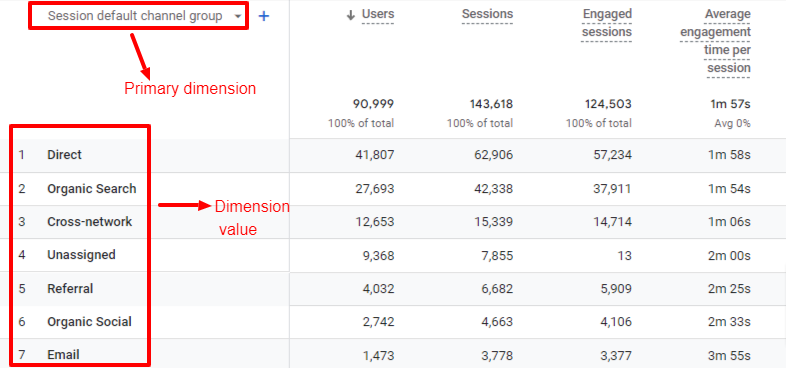Understanding Secondary Dimension in Google Analytics: A Full Guide
Understanding Secondary Dimension in Google Analytics: A Full Guide
Blog Article
Transform Your Analytics Strategy With Secondary Measurement in Google Analytics
Discovering the possibility of additional dimensions in Google Analytics opens a realm of possibilities for services seeking to boost their logical approach. By integrating additional dimensions into information analysis, a new layer of understandings emerges, shedding light on complex individual habits and communications. This sophisticated level of scrutiny not just improves advertising and marketing approaches yet likewise unravels hidden chances for optimization and growth. The tactical application of additional dimensions holds the vital to unlocking a gold mine of very useful details that can transform how businesses act and analyze upon their data.
Comprehending Second Dimensions in Google Analytics
Secondary measurements in Google Analytics supply additional context to main data by enabling customers to evaluate metrics throughout a 2nd dimension, using much deeper insights into customer actions and interactions on a web site. Secondary Dimension in Google Analytics. While key dimensions supply basic data points such as pageviews, bounce price, and session period, secondary measurements offer a more in-depth sight by segmenting the key information better. This segmentation allows individuals to examine metrics in mix with an additional dimension, such as web traffic resources, demographics, or user habits
Advantages of Utilizing Second Dimensions
Utilizing additional measurements in Google Analytics uses a critical benefit by boosting the deepness of evaluation and providing a much more thorough understanding of user interactions and actions on an internet site. By integrating additional measurements, analysts can acquire useful insights into the efficiency of specific sectors or variables within their data. This allows an extra detailed evaluation of customer habits past surface-level metrics, enabling a deeper exploration of the elements affecting user interaction and conversions.

How to Execute Additional Dimensions
When integrating second dimensions in Google Analytics, one essential action is to select the appropriate metrics and measurements to improve the evaluation process. Clicking on this button will open up a drop-down menu listing different dimensions that can be included to your key dimension for deeper insights.
After selecting the proper additional measurement, such as 'Source/Medium' or 'Device Category,' Google Analytics will display the information in an extra detailed style, enabling you to cross-analyze different facets of customer actions. Bear in mind to try out different combinations of explanation primary and second dimensions to discover useful patterns and patterns that can educate your advertising methods. By executing additional measurements thoughtfully, you can get a much more extensive understanding of your site or application performance and make data-driven choices to enhance your digital visibility.
Analyzing Information With Second Measurements
Boost your information analysis in Google Analytics by including second dimensions to dive deeper into user habits patterns and enhance your electronic marketing strategies effectively - Secondary Dimension in Google Analytics. By including second measurements to your primary data, you can acquire valuable insights that can help you make informed choices regarding your internet site or app performance
Analyzing pop over here information with secondary dimensions allows you to sector your primary data further, giving a much more extensive sight of customer interactions. As an example, incorporating the primary measurement of 'source/medium' with a second measurement like 'touchdown web page' can expose which certain pages are driving website traffic from different sources. This information can be critical in improving your material approach or enhancing your advertising and marketing campaigns to enhance conversions.
Moreover, using second dimensions allows you to determine connections between different metrics, helping you recognize the influence of different variables on customer actions. Whether it's assessing demographics alongside individual interaction metrics or tool classifications with conversion rates, additional dimensions empower you to discover covert trends and patterns that can assist your marketing initiatives.
Enhancing Performance With Second Dimensions
To enhance the effectiveness of information evaluation and decision-making in Google Analytics, incorporating additional dimensions is key to optimizing performance metrics and gaining deeper understandings into individual habits patterns. By using additional measurements, analysts can dive beyond surface-level data and discover beneficial connections that might or else go undetected. This optimization strategy makes it possible for services to tailor their advertising initiatives more effectively, recognize locations for improvement in website usability, and improve general individual experience.
Second dimensions supply an even more comprehensive view of customer interactions by offering added context to main information metrics. For instance, coupling the main dimension of 'touchdown web page' with a second measurement like 'gadget category' can expose whether certain gadgets are much more likely to drive interaction on particular touchdown web pages. This understanding can notify receptive design renovations or targeted marketing strategies to enhance performance.

Conclusion
In conclusion, the combination browse around here of second dimensions in Google Analytics offers services with a powerful tool to boost their analytics strategy. Secondary Dimension in Google Analytics. By delving deeper into user actions and communications, online marketers can reveal useful understandings that can drive performance optimization and enhance the overall customer experience. Leveraging second measurements permits for a more comprehensive analysis of information, causing more informed decision-making and customized advertising efforts
Additional measurements in Google Analytics give additional context to key data by permitting individuals to evaluate metrics throughout a 2nd dimension, offering much deeper insights right into customer behavior and communications on a website. While main measurements give fundamental data points such as pageviews, bounce rate, and session period, second dimensions provide a more detailed view by segmenting the main information additionally.One of the essential advantages of using additional measurements is the capability to reveal relationships and patterns that might not be right away noticeable when assessing information with key measurements alone.When integrating additional dimensions in Google Analytics, one essential step is to pick the appropriate metrics and measurements to improve the evaluation procedure. Pairing the key dimension of 'touchdown web page' with a second dimension like 'device group' can reveal whether particular tools are extra likely to drive engagement on specific landing pages.
Report this page